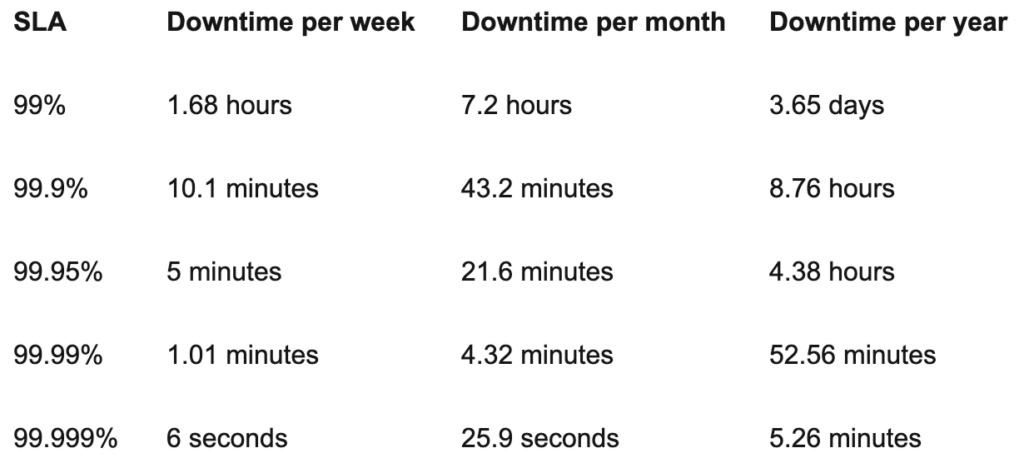Introduction
In today’s rapidly evolving technological landscape, the reliability of application services stands as a cornerstone for customer satisfaction and successful contract fulfillments. Amidst the complexities, the concept of error budgets emerges as a powerful strategy, providing a dynamic framework to balance reliability, innovation, and strategic investments. This comprehensive guide aims to delve deeper into the fundamentals of error budgets; their components, strategic importance, and the creation of effective error budget policies.
Understanding Error Budgets:
At its essence, an error budget defines the maximum allowable time for a technical system to encounter failures without triggering contractual consequences. Consider a scenario where a Service Level Agreement (SLA) promises 99.99% uptime — this translates into an error budget allowing 52.56 minutes of system downtime annually (See table below) without compensating customers. This metric serves as a critical threshold for evaluating the reliability of a system.
How to use an error budget:
To optimize utilization of the error budget, commence by consulting your SLAs and Service Level Objectives (SLOs). What objectives have you set for system uptime and the successful fulfillment of system requests? What obligations has your organization pledged to its clients? These elements will serve as the foundational principles directing your error budget strategy.
Error Budgets Aligned with Uptime:
Typically, teams monitor uptime on a monthly basis. If the system’s availability exceeds the number outlined in the SLA/SLO, the team has the green light to introduce new features and modernize the system. However, if it falls below the target, all feature releases pause until the system gets back on track.
For this approach to be effective, you’ll need to convert your SLO target (usually expressed as a percentage) into tangible figures that developers can work with. This involves calculating the actual hours and minutes corresponding to your allowed downtime percentages.
The following table defines common SLA values:

Components of Error Budgets:
To formulate a comprehensive error budget strategy, understanding its components is imperative. This involves a meticulous error budget analysis, clearly defining acceptable errors within specific timeframes, and seeking guidance from experienced Chief Technology Officers (CTOs). 7CTOs Coaching can provide valuable insights into effective error budget management.
Significance of Error Budgets
Beyond being a mere metric, error budgets play a pivotal role in striking a delicate balance between innovation and stability. The Google Site Reliability Engineering (SRE) book underscores the significance of error budgets, emphasizing that targeting 100% reliability is often misguided. Instead, determining the right reliability target is framed as a product-oriented question, considering user satisfaction levels and alternatives available to users dissatisfied with a product’s availability.
Navigating the Trade-Off: The Need for an Error Budget
In the realm of technology, every decision involves a trade-off. The structural conflict between the pace of innovation and product stability necessitates a nuanced approach. The error budget emerges as a data-driven mechanism to advocate for long-term development velocity. It prompts considerations such as when to prioritize bugs and post-mortem actions in planning cycles and when to implement automation, monitoring, and observability.
An error budget allows organizations to allocate resources strategically. If there’s room in the budget, it can be spent on new features; otherwise, innovation expenses need to be curtailed. The exhaustion rate of the error budget becomes a crucial metric — if it exceeds 1, it indicates that the budget is being consumed faster than optimal, leading to a form of technical debt.
The Error Budget Equation: Balancing Act for Reliability
The error budget equation,
Error Budget = 1 − Availability Target
serves as a foundational principle for managing unavailability and increasing overall system reliability. It emphasizes reducing Time-To-Detect (TTD), Time-To-Resolution (TTR), and Time-To-Failure/Time-Between-Failures (TTF/TBF). Organizations can strategically decrease unavailability by improving monitoring and alerting systems, streamlining troubleshooting processes, and understanding and addressing the root causes of failures.
Crafting a Robust Error Budget Policy:
Developing a robust error budget policy is a multifaceted process that requires careful attention to specific properties for effective implementation:
– Enforcement Mechanism: The policy should robustly enforce engineering efforts to prioritize reliability when the error budget is exhausted or under threat.
– Re-prioritization Criteria: Clearly defining when re-prioritization takes effect, ensuring clarity and consistency in decision-making.
– Reliability Work Allocation: Describing how teams will prioritize reliability work based on the status of the error budget, fostering a proactive approach.
– Consequences for Non-Compliance: Establishing clear consequences and risks for teams not adhering to the policy, emphasizing the centrality of reliability work.
– Consistency Across Teams: Ensuring uniform application of the policy across teams throughout the year, with minimal exceptions.
– Final Decision-Maker: Designating a final owner and decision-maker to resolve disputes and ensure effective policy implementation.
– Incorporation of Feedback: Actively analyzing and incorporating feedback from all stakeholders to refine and optimize the policy over time.
Strategic Investments and Trade-Offs:
The Google SRE book introduces the concept that product performance is evaluated using velocity, while platform performance is assessed using reliability. This sets the stage for the constant negotiation between Product/Engineering and Business to strike a balance between the value added by new features and the value lost through bugs, outages, and technical debt. An Error Budget serves as a data-driven tool to convince leadership to invest in development velocity for the long run.
The Role of Error Budgets in Risk Management:
The Google SRE methodology introduces the notion of a risk matrix, a tool useful for calculating the level of risk based on the probability and severity of an event. Applying this concept to error budgets provides a nuanced understanding of risk, especially in the context of SLOs.
Considerations in risk management include:
– Likelihood: Measured by Mean-Between-Failure (MTBF).
– Impact: Measured by Mean-Time-To-Recover (MTTR).
– Acceptable Risk: Set by the Error Budget.
– Target Availability: Defined by the SLO.
By creating a catalog of risks and using a traffic light system to visually represent their ranking, organizations gain insights into which risks are unacceptable, need urgent attention, or are acceptable based on their impact on the error budget.
Conclusion: Embracing a Culture of Reliability and Innovation
In conclusion, error budgets emerge as a powerful and dynamic tool for managing the reliability of application services while fostering a culture of innovation. By understanding the components, strategic significance, and properties of effective error budget policies, organizations can navigate the delicate balance between reliability and innovation successfully.
Embrace error budgets not just as metrics but as catalysts for continuous improvement, customer satisfaction, and the long-term success of your technological endeavors.




